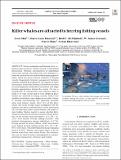Killer whales are attracted to herring fishing vessels
Abstract
Marine mammals and fisheries often target the same resources, which can lead to operational interactions. Potential consequences of operational interaction include entanglements and damaged or reduced catches but also enhanced foraging opportunities, which can attract marine mammals to fishing vessels. Responsible fisheries management therefore requires detailed knowledge of the impact of these interactions. In northern Norway, killer whales Orcinus orca are frequently observed in association with large herring aggregations during the winter. We use a combination of biotelemetry and fisheries data to study if, to what extent and at what distances killer whales are attracted to fishing activity. Twenty-five satellite transmitters were deployed on killer whales at herring overwintering and spawning grounds, often near fishing vessels. Over 50% of the killer whale core areas of high usage overlapped with the fisheries core areas, and individual whales spent up to 34% of their time close to active fishing. We used a 3-state hidden Markov model to assess whether killer whale movements were biased towards fishing activities. Of the overall whale movements, 15% (CI = 11− 21%) were biased towards fishing activities, with marked heterogeneity among individuals (0−57%). During periods of active fishing, whale movements were biased towards fishing events 44% (CI = 24− 66%) of the time, with individual percentages ranging from 0 to 79%. Whales were more likely to be attracted when they were within 20 km. This information can be used in fishery management to consider potential consequences for fishers and whales.
Citation
Mul , E , Blanchet , M A , McClintock , B T , Grecian , W J , Biuw , M & Rikardsen , A 2020 , ' Killer whales are attracted to herring fishing vessels ' , Marine Ecology Progress Series , vol. 652 , pp. 1-13 . https://doi.org/10.3354/meps13481
Publication
Marine Ecology Progress Series
Status
Peer reviewed
ISSN
0171-8630Type
Journal article
Description
E.M. was funded by a PhD scholarship from VISTA, which is a basic research programme in collaboration between The Norwegian Academy of Science & Letters and Equinor. The fieldwork was partly financed by the Regional Norwegian Research Counsel (Whalefeast project, RFFNORD no. 282469).Collections
Items in the St Andrews Research Repository are protected by copyright, with all rights reserved, unless otherwise indicated.

